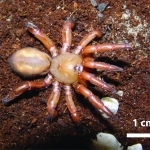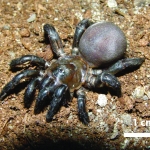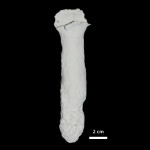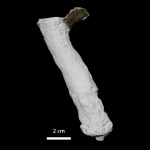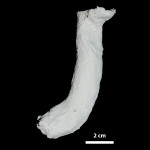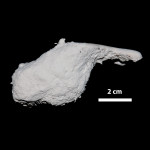South African Trapdoor Spider (Gorgyrella inermis)
For full details see Hils and Hembree (2015) in Palaeontologia Electronica.
Description of Organism
- Mygalomorph spider of the family Idiopodae.
- Possesses short legs and a thick abdomen
- Inhabits grasslands of South Africa.
- Nocturnal ambush predators that spend the majority of their lives in burrows.
- Lifespan of up to 10 years
Published Descriptions of Organism
Hils and Hembree (2014):
- Spiders (Order Araneae) belong to Subphylum Chelicerata. Chelicerates first appeared during the Cambrian. They are defined by the presence of chelicerae, a pair of joined pincers present on the second segment of the body, pedilapalps located near the mouth, four pairs of walking legs, and the absence of antennae, mandibles, and wings. Members of Class Arachnida first appear during the Silurian. The earliest arachnids were marine, but nearly all modern arachnids are terrestrial. There are approximately 97,000 described extant species of arachnids. Arachnid bodies are divided into two sections: the anterior cephalothorax and the posterior abdomen. Arachnids use pedipalps, non-walking appendages near the chelicerae, to grab and kill prey as well as to assist in reproduction.
- Gorgyrella inermis belongs to the mygalomorph family Idiopodae, which is known only from the recent. Members of this family are typically nocturnal ambush predators that wait for prey at the opening of their burrows. Gorgyrella inermis is native to the grasslands of South Africa. These spiders have short legs and thick abdomens and may live up to 10 years. The burrows of G. inermis have been described as long, simple shafts with an oval shaped opening. The trapdoor is D-shaped and very wide with a hinge that exceeds the width of the burrow.
Burrowing Technique
Gorgyrella inermis produces burrows in two ways. Smaller individuals compact sediment along the sides of burrows with no excavation. Larger individuals wrap sediment excavated from the base of the burrow in silk and throw these packets out of the burrow. These packets can land up to 27 cm from the burrow opening. Gorgyrella inermis moves and carries sediment with its pedipalps and chelicerae. The sides of the burrows are lined with silk; thicker linings are developed in less cohesive sediment. Gorgyrella inermis makes thick burrow trapdoors constructed of sediment and silk attached to one side of the burrow opening with a hinge. Individuals of G. inermis often search for and reattach trapdoors when they are removed.
Burrowing Technique Videos
Burrowing Behavior
Gorgyrella inermis begins to burrow within 0-15 days of being placed in experimental enclosures with an average of 5 days to begin burrowing. The smaller individuals tend to burrow faster than larger ones. Over this time the individuals move around the space provided testing the enclosure and obstructions. While burrows may be placed anywhere in the experimental enclosures, most are located along the enclosure walls. The burrows were used for dwelling and ambush hunting. Individuals did not leave their burrows once they were constructed; to obtain prey G. inermis waited near the top of its burrow and grabbed prey that moved near the entrance with its pedipalps and front legs. The prey was pulled down into the burrow for consumption. Gorgyrella inermis excretes waste by climbing to the top of the burrow and forcefully expelling the waste away from the burrow opening.
Trace Morphology
Gorgyrella inermis produces four distinct burrow architectures: vertical shafts, subvertical ramps, J-shaped burrows, and isolated chambers; examples of each are shown below. Each photo is linked to an information page about the specific architecture.
Click here for the complete photographic archive of all burrows produced by Gorgyrella inermis.
